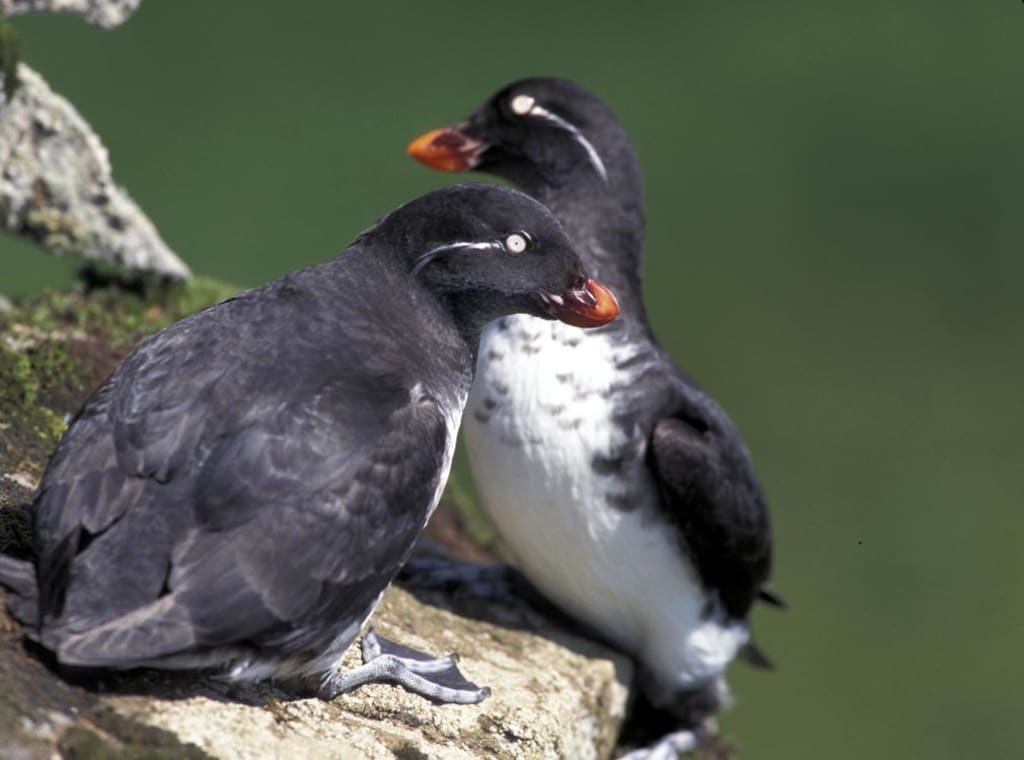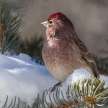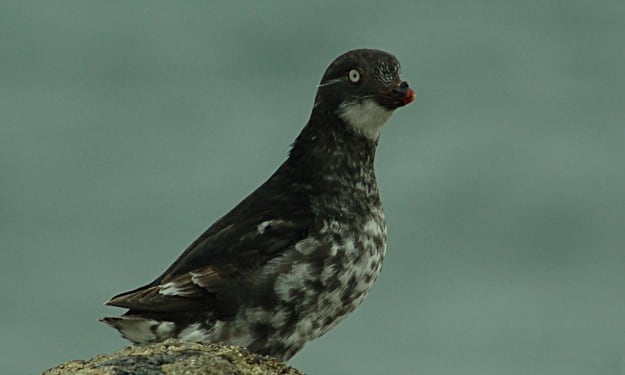
The parakeet auklet (Aethia psittacula) is a Small Seabird in the North Pacific. Parakeet Auklets used to be placed alone in the Cyclorrhynchus group, but recent morphological and genetic evidence suggest it should be grouped into the Aethia tribe, rendering it closely related to crested auklets and less auklets. It is correlated with the Boreal waters of Alaska, Kamchatka, and Siberia. This breeds offshore islands, usually going south in winter, on cliffs, hills, and boulder fields. The parakeet auklet is a tiny auk with a brief orange bill upturned to give the bird a strange fixed voice.
The bird's plumage is dark overhead, and white below. With a small white plume extending out of the mouth. In winter there is a slight variation between breeding and plumage. The parakeet auklet is an incredibly aggressive species in the nest, calling until it reaches the nest, and then dueting before its mate comes in. It produces a series of rhythmic hoarse calls, and a quavering squeal. Their role is uncertain but may be linked to defending their burrow against intruders and reinforcing the bond with their spouse. Feed for the parakeet auklet varies with season, bringing in the breeding season primarily small planktonic crustaceans such as euphausiids, copepods, and amphipods. Recent research shows that he also preys on jellyfish in some places.
This also feeds at a large distance from the nest, diving up to 30 metres to catch its prey. Breeding starts in April and May, and is also shared in colonies with other auks species. The pair lay one egg that has been incubated for just over a month, and then the chick is fed 4 times a day for about 35 days. The chick flees at dusk, going to shore alone. The parakeet auklet is not deemed extinct, over one million people are known to be in the North Pacific. This is not believed to have deteriorated lately, but may be threatened in the future by new rodents and oil spills. A small fishing and diving seabird, summering in the Bering Sea and the South coast of Alaska. Not big flocks, usually in small groups or in pairs. He also nests on the same islands as Crested and Least auklets, but is typically smaller in size. Often known in winter, as it may spread far away in the middle of the North Pacific. It forages by shallow diving and floating underwater, or may dig on the shallow while floating. We lay from light blue to brown egg. For both sexes the incubation lasts about 36 days. All parents eat young, taking food to sleep in their neck pockets. Young leaves nests about 5 weeks after hatching, and heads for shore. Its diet is mostly jellyfish and occasionally crustaceans. It evidently specialises in jellyfish and other gelatinous species, at least in the summer; the odd shape of the bill can be adapted to accommodate these slippery preys.
This also feeds on crustaceans and several small fish, including shrimp and amphipod euphausiids. It appears in isolated pairs or loose groups, not grouped so densely as Crested or Least auklets, but even similar to them. Adults arrive 4-6 weeks before egg laying starts in colonial field. The nest site is situated in heavily eroded or decomposed ledge, hill, rocky outcrop, or partly concealed by vegetation on the talus slope. And even in places where the mix of rock and gravel is not pure soil as in Crested Auklet. Nest is in deep crevice; no additional nesting material, eggs laid on bare soil or rock, is available. Parakeet Auklets often consume pellets of plastic which they use to float at sea. Although it is likely that these pellets can be ingested, no adverse effects have yet been reported. The unusual bill shape is probably the adaptation to handle slimy gelatinous prey, like jellyfish, although how the bill is used is uncertain. Parakeet Auklets walk on the field, mostly legs and not feet.
About the Creator
MB
I am a bird aficionado and really enjoy spotting them them on hikes. I greatly appreciate the variety of birds cross North America and the world. They are amazing and intelligent creatures, each so unique and with a wonderful life.






Comments
There are no comments for this story
Be the first to respond and start the conversation.